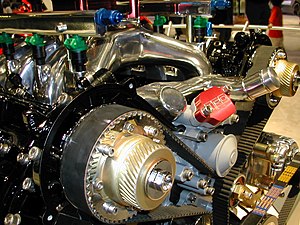 Image via Wikipedia
Image via Wikipedia
GM’s continuing development of homogenous charge compression ignition (HCCI) is pushing this promising, fuel-saving and emissions-reducing engine technology closer to production reality. An HCCI engine, when combined with other advanced technologies, provides up to 15 percent greater fuel economy than a comparable, non-HCCI engine by radically altering the combustion process.
“HCCI delivers enhanced fuel savings without sacrificing the performance consumers have come to expect,” said Prof. Dr. Uwe Grebe, executive director for GM Powertrain Advanced Engineering. “It is a great example of how GM is developing advanced engine technology for consumers that squeezes more miles per gallon of gas and reduces emissions.”
In general terms, the heat and pressure within an HCCI engine’s cylinders are used to ignite the air/fuel mixture without the aid of a traditional spark-generated flame – roughly analogous to the combustion process of a diesel engine. Heat is a necessary enabler for the HCCI process, so traditional spark ignition is used when the engine is cold to generate heat within the cylinders and instigate “auto-ignition” of the mixture.
More than a laboratory experiment, HCCI has been successfully demonstrated in prototype models in North America and Europe. Last spring, GM took the technology on the road, putting journalists and others in an HCCI-equipped Saturn Aura for real-world drives in Los Angeles, Washington, D.C., and New York. The vehicle featured the breakthrough of auto-ignition (HCCI) from idle to 60 mph, which significantly advances the benefits of HCCI and the viability for production.
The increase in the HCCI operating range of the prototype vehicle is the result of a patented mixed-mode calibration that includes pre-reacting fuel and exhaust gas in the cylinder to bolster the pressure and heat needed for auto-ignition.
The advantages and challenges of HCCI
HCCI’s efficiency comes from reduced pumping losses, burning fuel faster at lower temperatures and reducing the heat energy lost during the combustion process. Consequently, less carbon dioxide is released because the engine’s operation in HCCI mode is more efficient.
During HCCI mode, the engine approaches the efficiency of a diesel, but unlike a diesel, it requires only a conventional exhaust system. Diesel engines require more elaborate and more expensive exhaust “aftertreatment” to reduce emissions.
The success of HCCI development, to date, is tempered by challenges that must be overcome before it hits the primetime of production. Control of the combustion process over the wide range of operating conditions experienced in everyday driving is the greatest challenge, because unlike a conventional-ignition engine, HCCI’s combustion is not controlled by precisely timed spark events. Ensuring auto ignition at extreme temperatures and in the thinner air of high altitudes are the tallest hurdles to overcome.
“GM’s global HCCI team is working to refine the technology in the wide range of driving conditions experienced around the globe,” said Dr. Grebe. “By combining HCCI with other advanced gasoline engine and control technologies, we can deliver a good fuel savings value for consumers.”
![Reblog this post [with Zemanta]](http://img.zemanta.com/reblog_e.png?x-id=d4b02f61-c2d7-4e7e-84d2-453c1296464b)
No comments:
Post a Comment